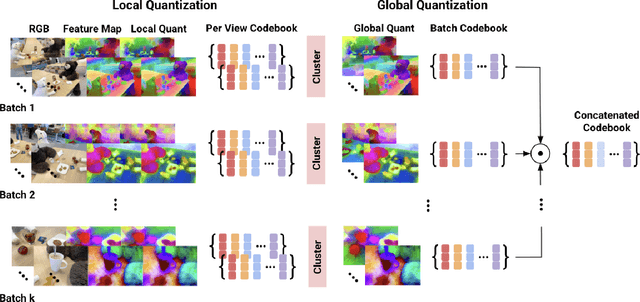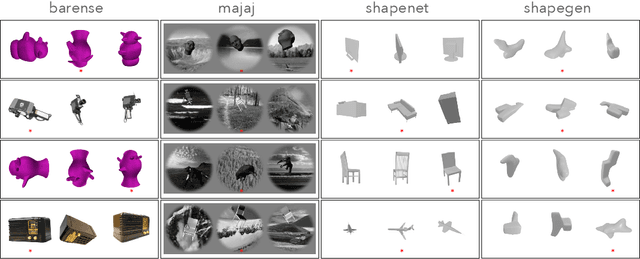Yutong Bai
Transformers Discover Molecular Structure Without Graph Priors
Oct 02, 2025



Abstract:Graph Neural Networks (GNNs) are the dominant architecture for molecular machine learning, particularly for molecular property prediction and machine learning interatomic potentials (MLIPs). GNNs perform message passing on predefined graphs often induced by a fixed radius cutoff or k-nearest neighbor scheme. While this design aligns with the locality present in many molecular tasks, a hard-coded graph can limit expressivity due to the fixed receptive field and slows down inference with sparse graph operations. In this work, we investigate whether pure, unmodified Transformers trained directly on Cartesian coordinates$\unicode{x2013}$without predefined graphs or physical priors$\unicode{x2013}$can approximate molecular energies and forces. As a starting point for our analysis, we demonstrate how to train a Transformer to competitive energy and force mean absolute errors under a matched training compute budget, relative to a state-of-the-art equivariant GNN on the OMol25 dataset. We discover that the Transformer learns physically consistent patterns$\unicode{x2013}$such as attention weights that decay inversely with interatomic distance$\unicode{x2013}$and flexibly adapts them across different molecular environments due to the absence of hard-coded biases. The use of a standard Transformer also unlocks predictable improvements with respect to scaling training resources, consistent with empirical scaling laws observed in other domains. Our results demonstrate that many favorable properties of GNNs can emerge adaptively in Transformers, challenging the necessity of hard-coded graph inductive biases and pointing toward standardized, scalable architectures for molecular modeling.
Whole-Body Conditioned Egocentric Video Prediction
Jun 26, 2025



Abstract:We train models to Predict Ego-centric Video from human Actions (PEVA), given the past video and an action represented by the relative 3D body pose. By conditioning on kinematic pose trajectories, structured by the joint hierarchy of the body, our model learns to simulate how physical human actions shape the environment from a first-person point of view. We train an auto-regressive conditional diffusion transformer on Nymeria, a large-scale dataset of real-world egocentric video and body pose capture. We further design a hierarchical evaluation protocol with increasingly challenging tasks, enabling a comprehensive analysis of the model's embodied prediction and control abilities. Our work represents an initial attempt to tackle the challenges of modeling complex real-world environments and embodied agent behaviors with video prediction from the perspective of a human.
TARDIS STRIDE: A Spatio-Temporal Road Image Dataset for Exploration and Autonomy
Jun 12, 2025Abstract:World models aim to simulate environments and enable effective agent behavior. However, modeling real-world environments presents unique challenges as they dynamically change across both space and, crucially, time. To capture these composed dynamics, we introduce a Spatio-Temporal Road Image Dataset for Exploration (STRIDE) permuting 360-degree panoramic imagery into rich interconnected observation, state and action nodes. Leveraging this structure, we can simultaneously model the relationship between egocentric views, positional coordinates, and movement commands across both space and time. We benchmark this dataset via TARDIS, a transformer-based generative world model that integrates spatial and temporal dynamics through a unified autoregressive framework trained on STRIDE. We demonstrate robust performance across a range of agentic tasks such as controllable photorealistic image synthesis, instruction following, autonomous self-control, and state-of-the-art georeferencing. These results suggest a promising direction towards sophisticated generalist agents--capable of understanding and manipulating the spatial and temporal aspects of their material environments--with enhanced embodied reasoning capabilities. Training code, datasets, and model checkpoints are made available at https://huggingface.co/datasets/Tera-AI/STRIDE.
AlphaOne: Reasoning Models Thinking Slow and Fast at Test Time
May 30, 2025Abstract:This paper presents AlphaOne ($\alpha$1), a universal framework for modulating reasoning progress in large reasoning models (LRMs) at test time. $\alpha$1 first introduces $\alpha$ moment, which represents the scaled thinking phase with a universal parameter $\alpha$. Within this scaled pre-$\alpha$ moment phase, it dynamically schedules slow thinking transitions by modeling the insertion of reasoning transition tokens as a Bernoulli stochastic process. After the $\alpha$ moment, $\alpha$1 deterministically terminates slow thinking with the end-of-thinking token, thereby fostering fast reasoning and efficient answer generation. This approach unifies and generalizes existing monotonic scaling methods by enabling flexible and dense slow-to-fast reasoning modulation. Extensive empirical studies on various challenging benchmarks across mathematical, coding, and scientific domains demonstrate $\alpha$1's superior reasoning capability and efficiency. Project page: https://alphaone-project.github.io/
REOrdering Patches Improves Vision Models
May 29, 2025Abstract:Sequence models such as transformers require inputs to be represented as one-dimensional sequences. In vision, this typically involves flattening images using a fixed row-major (raster-scan) order. While full self-attention is permutation-equivariant, modern long-sequence transformers increasingly rely on architectural approximations that break this invariance and introduce sensitivity to patch ordering. We show that patch order significantly affects model performance in such settings, with simple alternatives like column-major or Hilbert curves yielding notable accuracy shifts. Motivated by this, we propose REOrder, a two-stage framework for discovering task-optimal patch orderings. First, we derive an information-theoretic prior by evaluating the compressibility of various patch sequences. Then, we learn a policy over permutations by optimizing a Plackett-Luce policy using REINFORCE. This approach enables efficient learning in a combinatorial permutation space. REOrder improves top-1 accuracy over row-major ordering on ImageNet-1K by up to 3.01% and Functional Map of the World by 13.35%.
"I Know It When I See It": Mood Spaces for Connecting and Expressing Visual Concepts
Apr 21, 2025



Abstract:Expressing complex concepts is easy when they can be labeled or quantified, but many ideas are hard to define yet instantly recognizable. We propose a Mood Board, where users convey abstract concepts with examples that hint at the intended direction of attribute changes. We compute an underlying Mood Space that 1) factors out irrelevant features and 2) finds the connections between images, thus bringing relevant concepts closer. We invent a fibration computation to compress/decompress pre-trained features into/from a compact space, 50-100x smaller. The main innovation is learning to mimic the pairwise affinity relationship of the image tokens across exemplars. To focus on the coarse-to-fine hierarchical structures in the Mood Space, we compute the top eigenvector structure from the affinity matrix and define a loss in the eigenvector space. The resulting Mood Space is locally linear and compact, allowing image-level operations, such as object averaging, visual analogy, and pose transfer, to be performed as a simple vector operation in Mood Space. Our learning is efficient in computation without any fine-tuning, needs only a few (2-20) exemplars, and takes less than a minute to learn.
Vector Quantized Feature Fields for Fast 3D Semantic Lifting
Mar 09, 2025



Abstract:We generalize lifting to semantic lifting by incorporating per-view masks that indicate relevant pixels for lifting tasks. These masks are determined by querying corresponding multiscale pixel-aligned feature maps, which are derived from scene representations such as distilled feature fields and feature point clouds. However, storing per-view feature maps rendered from distilled feature fields is impractical, and feature point clouds are expensive to store and query. To enable lightweight on-demand retrieval of pixel-aligned relevance masks, we introduce the Vector-Quantized Feature Field. We demonstrate the effectiveness of the Vector-Quantized Feature Field on complex indoor and outdoor scenes. Semantic lifting, when paired with a Vector-Quantized Feature Field, can unlock a myriad of applications in scene representation and embodied intelligence. Specifically, we showcase how our method enables text-driven localized scene editing and significantly improves the efficiency of embodied question answering.
AV-Odyssey Bench: Can Your Multimodal LLMs Really Understand Audio-Visual Information?
Dec 03, 2024



Abstract:Recently, multimodal large language models (MLLMs), such as GPT-4o, Gemini 1.5 Pro, and Reka Core, have expanded their capabilities to include vision and audio modalities. While these models demonstrate impressive performance across a wide range of audio-visual applications, our proposed DeafTest reveals that MLLMs often struggle with simple tasks humans find trivial: 1) determining which of two sounds is louder, and 2) determining which of two sounds has a higher pitch. Motivated by these observations, we introduce AV-Odyssey Bench, a comprehensive audio-visual benchmark designed to assess whether those MLLMs can truly understand the audio-visual information. This benchmark encompasses 4,555 carefully crafted problems, each incorporating text, visual, and audio components. To successfully infer answers, models must effectively leverage clues from both visual and audio inputs. To ensure precise and objective evaluation of MLLM responses, we have structured the questions as multiple-choice, eliminating the need for human evaluation or LLM-assisted assessment. We benchmark a series of closed-source and open-source models and summarize the observations. By revealing the limitations of current models, we aim to provide useful insight for future dataset collection and model development.
Analyzing The Language of Visual Tokens
Nov 07, 2024



Abstract:With the introduction of transformer-based models for vision and language tasks, such as LLaVA and Chameleon, there has been renewed interest in the discrete tokenized representation of images. These models often treat image patches as discrete tokens, analogous to words in natural language, learning joint alignments between visual and human languages. However, little is known about the statistical behavior of these visual languages - whether they follow similar frequency distributions, grammatical structures, or topologies as natural languages. In this paper, we take a natural-language-centric approach to analyzing discrete visual languages and uncover striking similarities and fundamental differences. We demonstrate that, although visual languages adhere to Zipfian distributions, higher token innovation drives greater entropy and lower compression, with tokens predominantly representing object parts, indicating intermediate granularity. We also show that visual languages lack cohesive grammatical structures, leading to higher perplexity and weaker hierarchical organization compared to natural languages. Finally, we demonstrate that, while vision models align more closely with natural languages than other models, this alignment remains significantly weaker than the cohesion found within natural languages. Through these experiments, we demonstrate how understanding the statistical properties of discrete visual languages can inform the design of more effective computer vision models.
Evaluating Multiview Object Consistency in Humans and Image Models
Sep 10, 2024



Abstract:We introduce a benchmark to directly evaluate the alignment between human observers and vision models on a 3D shape inference task. We leverage an experimental design from the cognitive sciences which requires zero-shot visual inferences about object shape: given a set of images, participants identify which contain the same/different objects, despite considerable viewpoint variation. We draw from a diverse range of images that include common objects (e.g., chairs) as well as abstract shapes (i.e., procedurally generated `nonsense' objects). After constructing over 2000 unique image sets, we administer these tasks to human participants, collecting 35K trials of behavioral data from over 500 participants. This includes explicit choice behaviors as well as intermediate measures, such as reaction time and gaze data. We then evaluate the performance of common vision models (e.g., DINOv2, MAE, CLIP). We find that humans outperform all models by a wide margin. Using a multi-scale evaluation approach, we identify underlying similarities and differences between models and humans: while human-model performance is correlated, humans allocate more time/processing on challenging trials. All images, data, and code can be accessed via our project page.
 Add to Chrome
Add to Chrome Add to Firefox
Add to Firefox Add to Edge
Add to Edge